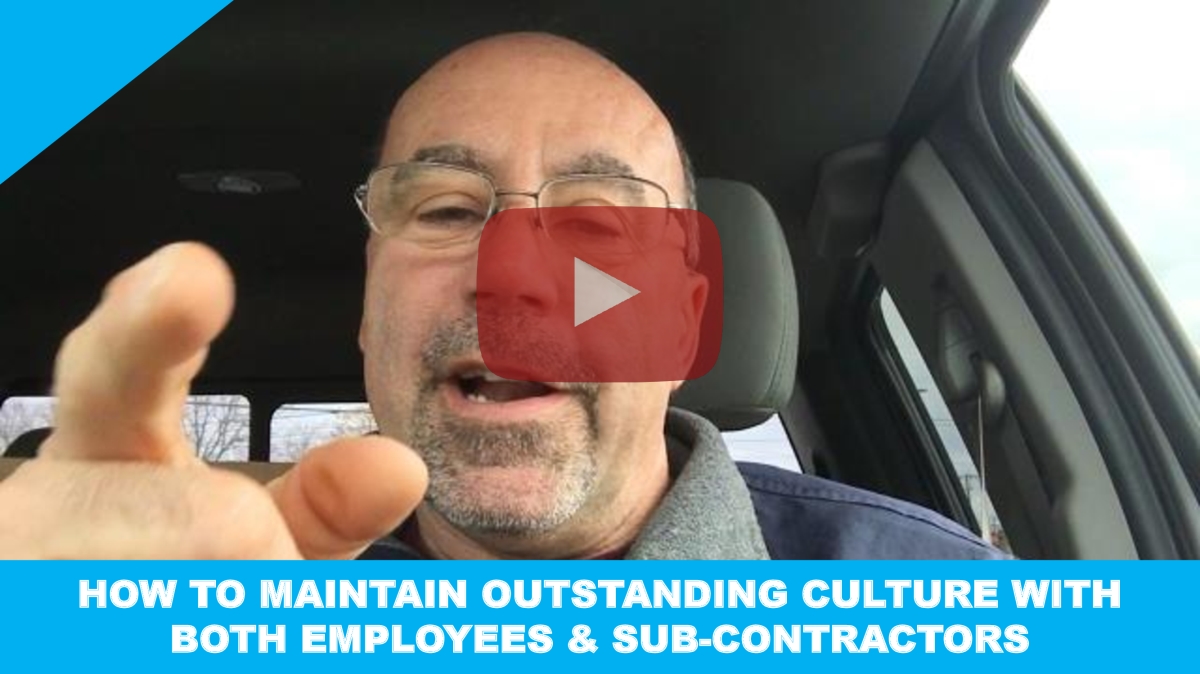
How to Maintain Outstanding Culture with both Employees and Sub-Contractors
Employees and Sub-Contractors; Do you have both? How do you keep the culture going, between the employees and how also do you keep it with the sub-contractors?
We’ve talked in the past about the employees, let’s dig down into the sub-contractor model.
I am Ron Ramsden, I am a DYB coach, also a painting contractor here in New England.
Sub-contractors: They come in, we have a sub-contractor agreement with them, basically all the rules to follow, as well as their percentages.
But other than finishing the job and making sure they get paid on time, how else do you build the culture with them?
We have a very robust process we use with our own employees, but really nothing has been touched on with the sub-contractors, and when you have both, it could be almost… they don’t mesh.
Let’s get them to mesh, I hope you can put one of these ideas, maybe one of these works, maybe all of them work, or maybe a piece of any of them will work for you.
First of all, what I would like to do is, if you are ever having a company party, company get together, and I highly recommend you do this, at least on a quarterly basis.
Download Your FREE Checklist...
11 Interview Questions For Hiring All-Stars, E-mailed to you NOW!

So, what do we do? Well, deep-sea fishing, if you are near the ocean. Go car riding, bowling, just a cookout, maybe it is a family fun day at the local amusement park, something like that.
We invite our employees, invite their families… invite the sub-contractors, these guys are making you money, they represent your company.
So, when we do these, we bring them together.
The first time, the second time. It might be a little stand at your office, and maybe a lot of them would not come, but some will and your employees will get to know them.
And before you know it, word will spread and they will all be showing up and will be looking forward to this.
And this is part of company culture, you are building it, it doesn’t happen overnight.
Secondly, what I like to do is, not only we give them our tee-shirts to wear, and our sweatshirts to wear, go out and buy them a really nice jacket.
Not only buy your employees a nice jacket but your sub-contractors nice jackets, with maybe their name on the sleeve, your logo on the chest, they’ll appreciate it, don’t ask anything from them.
Even if they are not working for you that month, maybe they’ve worked with you in the last 3 months and you have some jobs for them, coming up, give them the jacket, call them, bring them into the office, and give them that jacket that is going to mean something to them.
Also, bonuses; and this is where it gets tricky, because we’ve mentioned in the past how we bonus our employees, and I will go over this real quick.
It’s that every job is assigned a number of hours, if it’s a $1,000 job, maybe it’s 20 hours.
So, if the employee finishes it in 16 hours, we put 4 hours towards the bonus pool, not at the full bill rate, at another bill rate, you can watch the video on that, we’ve had a couple of them.
So, how do we bonus? And that’s paid out quarterly by the way, for the employees.
How do we bonus a sub-contractor?
It gets tough because a sub-contractor actually works on a percentage. So, if it’s a $10,000 job, they already know, going into it, what their walkaway is.
What they are going to take off there, depending on the materials, that’s a different story.
But they know what their percentage is.
So, how do we bonus this? Well, this is a way that might work for you.
We don’t do monthly bonuses, there are too many outside factors in a monthly bonus, especially if you are an exterior painter.
It’s weather, materials not being on the job site, especially contractor not being ready for us, or is half-ready for us.
Or they say it’s ready for us, and the crew gets on the job site and he’s honestly not ready for us, and that’s probably happened to you in the past.
Also, do that quarterly bonus.
And what works for us is, they not only have a survey where they have to get so many stars to get so much check marks from the homeowner or whoever they are working for, to make sure that they are working what they are supposed to be doing, following our direction.
If they are a $20,000 a month sub-contractor for you, in the course of 3 months, generally they are going to average about $60,000.
But what we want to do is to push that $60,000 higher so they can finish more work.
We are not going to give them a higher percentage, what we will do is we are going to give them a bonus at the end of the quarter to reach to a new level.
So if they have been doing $20,000 a month for us, on a quarter, that’s 3 months, it’s $60,000, we want them to hit $75,000, and a good rating on their service.
What we are going to do is, if you hit $75,000, your first idea is to give them cash, well that’s all well and good, but that extra $15,000, if we are giving them cash, we are really hitting hard on our percentage and it trickles down to our net profit.
What I like to do is, either give them a $2,000 gift card to the local paint store… wherever you buy ladders and paints or supplies, or a beautiful sprayer, a $2,500 paint sprayer.
Something that they are not going to go out on their own and buy, maybe it’s a dream thing that they would like to have.
You go out and you follow through with something like this, you are not only going to build culture, they are going to trust you and they are going to want to work for you for a long time.
Anyways, if you have any ideas, how you build culture, if you would like to share them with us, please comment below, I would love to hear them so I can share them with other contractors.
We are all in this together.
I am Ron Ramsden and I am a DYB coach, also a painting contractor.
If you would like to reach out to me, its dybcoach.com.
Also, you can find me on Facebook, send me a message, we can chat via that way, or we can actually grab the phone and talk that way.
Anyways, keep busy, keep profitable, and I’ll talk to you soon. Bye.
